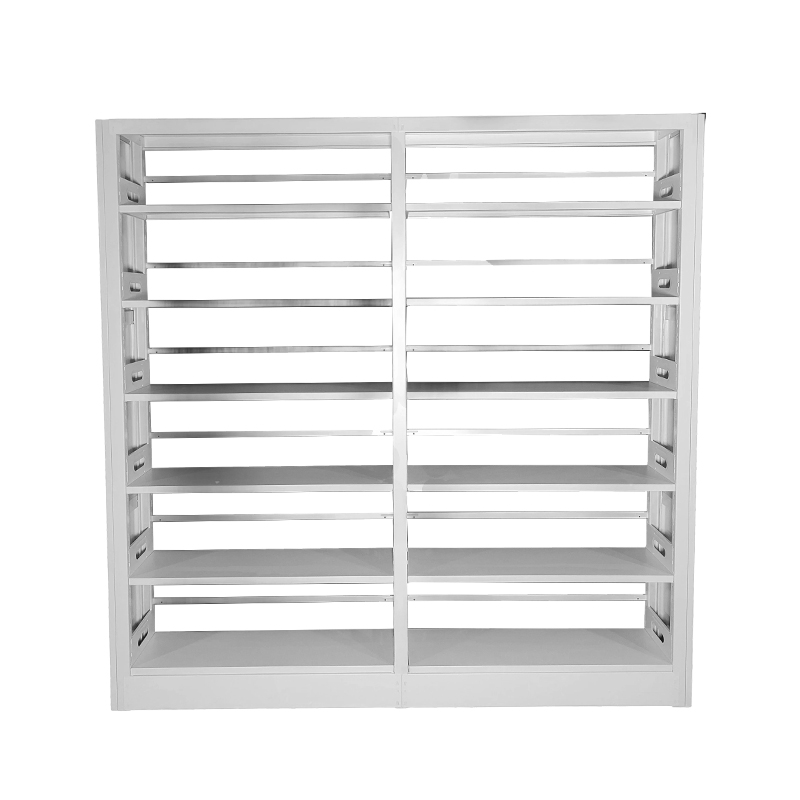What kind of mechanical reinforcement method is used in the connection structure between steel bookshelf columns and beams?
Release Time : 2025-10-11
The connection between the columns and beams of a steel bookshelf is crucial for ensuring overall stability and load-bearing capacity. Mechanical reinforcement methods must be designed based on a comprehensive consideration of material properties, stress conditions, and long-term use requirements. Common reinforcement methods include welding, bolting, angle brackets, and ferrule-type connections, each utilizing different mechanical principles to enhance connection strength.
Welding is one of the most widely used connection methods in steel bookshelves. It utilizes high-temperature molten metal to create a permanent bond between the columns and beams. During the welding process, the molten metal fills the joint gap and, upon cooling, forms a high-strength metallurgical bond that effectively transmits shear forces, bending moments, and torque. This reinforcement method offers advantages such as high connection rigidity and structural integrity, making it particularly suitable for heavy bookshelves requiring high stability. However, welding can lead to localized thermal stress concentrations, necessitating weld quality inspection and subsequent polishing to ensure connection reliability. Furthermore, attention should be paid to the impact of welding deformation on the verticality of the bookshelf.
Bolted connections achieve a removable connection between columns and beams through mechanical interlocking. Their mechanical principle relies on the friction generated by the bolt preload. During the tightening process, high-strength bolts create compression between the shank and the wall of the connecting member, creating sufficient friction to resist external forces. This reinforcement method offers the advantages of easy installation, repeatable disassembly, and ease of transportation and maintenance. To enhance connection stability, a double-nut locking design or spring washers are often used. Furthermore, it is important to ensure that the bolt preload is evenly distributed to prevent localized loosening and failure.
Angle bracket reinforcement is a common auxiliary reinforcement method used in steel bookshelves. It indirectly connects the columns and beams using L-shaped or T-shaped metal brackets. One side of the bracket is fixed to the column, while the other side is connected to the beam, forming a stable triangular support structure. This reinforcement method effectively distributes concentrated loads and reduces stress concentration at the joint. The brackets are typically made of the same steel as the bookshelf body and are secured to the columns by welding or bolts. The beams are connected to the brackets via bolts or slots. Its advantages lie in its flexible structure and adaptability, making it particularly suitable for unusually shaped bookshelves or for applications requiring adjustable shelf heights.
Sleeve-and-socket reinforcement uses an embedded structure to enhance connection stability. The principle is to insert a metal sleeve into the column, insert the end of the crossbeam into the sleeve, and then secure it with bolts or welding. The sleeve fits tightly against the inner wall of the column, forming an interference fit that effectively resists lateral shear and torsional moments. This reinforcement method offers the advantages of a concealed connection and a clean appearance, while the sleeve also enhances the local load-bearing capacity of the column. To ensure sleeve-and-socket accuracy, the tolerances between the column's inner diameter and the sleeve's outer diameter must be strictly controlled, and appropriate pressure must be applied during assembly to ensure tight contact.
In practice, steel bookshelf connections often utilize a combination of various reinforcement methods. For example, welding is used to ensure overall rigidity for the main frame, while bolts or brackets are used to connect the shelves to the crossbeams for adjustability. This composite design ensures both load-bearing capacity and flexibility. In addition, Hyundai Steel Bookshelf also optimizes the connection structure through finite element analysis and simulates the stress distribution under different load conditions, further improving the reliability and safety of the connection.





